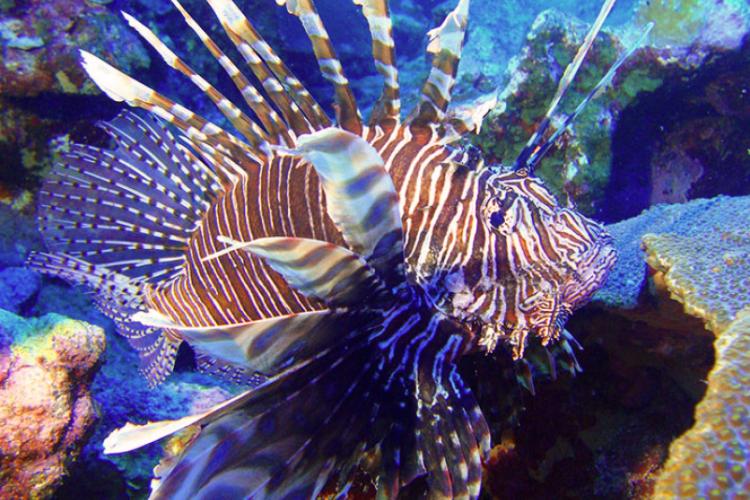Lionfish have become the poster child for invasive species issues in the western north Atlantic region. Their notoriety as invaders is on par with zebra mussels, snakeheads, and even Asian carp. Their populations continue to expand, threatening the well-being of coral reefs and other marine ecosystems. This includes the commercially and recreationally important fish that depend on them. NOAA and its partners are working hard to develop ways to prevent further spread and control existing populations.
History
The common name “lionfish” refers to two closely-related and nearly indistinguishable species that are invasive in U.S. waters. Lionfish, which are native to the Indo-Pacific, were first detected along Florida coasts in the mid-1980s. Their populations have swelled dramatically in the past 15 years. Lionfish are popular with aquarists, so it is plausible that repeated escapes into the wild via aquarium releases are the cause for the invasion. Lionfish now inhabit reefs, wrecks, and other habitat types in the warm marine waters of the greater Atlantic.
Lionfish continue to expand at astonishing speeds and are harming native coral reef ecosystems in the Atlantic, Gulf of Mexico, and Caribbean. Biologists suspect that lionfish populations have not yet peaked in the Gulf of Mexico, which means that their demand for native prey will continue to increase. Recent research has also revealed that lionfish can tolerate brackish coastal zones. Mangrove and estuarine habitats may also be at risk of invasion.
Impacts to Native Fish and Coral Reefs
Adult lionfish are primarily fish-eaters and have very few predators outside of their home range. Researchers have discovered that a single lionfish residing on a coral reef can reduce recruitment of native reef fish by 79 percent. Lionfish feed on prey normally consumed by snappers, groupers, and other commercially important native species. This means their presence could negatively affect the well-being of valuable commercial and recreational fisheries.
As lionfish populations grow, they put additional stress on coral reefs. For example, lionfish eat herbivores, and herbivores eat algae from coral reefs. Without herbivores, algal growth goes unchecked, which can be detrimental to the health of coral reefs.
These reefs are already struggling from the effects of climate change, pollution, disease, overfishing, sedimentation, and other stressors. This has led to the listing of seven coral species in the lionfish-infested area.
What’s Next for Lionfish?
NOAA has created an Invasive Lionfish Web Portal. It's a clearinghouse for all things related to lionfish outreach and education, research, monitoring, and management.
NOAA researcher and lionfish expert Dr. James Morris hosted a lionfish symposium at the 2014 meeting of the Gulf and Caribbean Fisheries Institute in Barbados. An earlier workshop focused on harvesting invasive lionfish found that:
- An invasive lionfish food fish market is practical, feasible, and should be promoted.
- Alternative invasive lionfish end-uses, such as the curio and aquarium trade, are also viable markets.
- Regarding consumption and the risk for ciguatera poisoning, invasive lionfish should not be treated differently than other tropical fish species and a general caution statement should be displayed within all establishments that serve fish and on all fish products.
- Local control is effective at minimizing invasive lionfish impacts at local scales and should be encouraged where possible.
Though no confirmed cases of ciguatera poisoning from eating lionfish have occurred, fears persist. If lionfish are proven to be safe, and if cost-effective harvest and distribution mechanisms are developed, small-scale fishermen may be able to capitalize while simultaneously helping to control the invasion.
Cooperation and communication among local, state, federal, and international partners is crucial for proper management of lionfish and other widespread invasive species. The Aquatic Nuisance Species Task Force developed a National Invasive Lionfish Prevention and Management Plan (pdf, 69 pages). NOAA’s National Marine Sanctuaries Program developed a lionfish plan that will guide the management of this invasive species in the affected sanctuaries in the Gulf and southeastern United States. Together, these plans will guide the management of invasive lionfish and ensure that all are working toward common objectives.
View an animated map of lionfish spread



